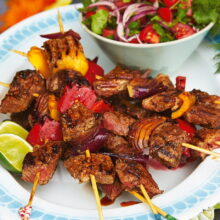Who Invented Barbecue?

Barbecue is one of the most popular dishes in America. It has a long history and is deeply tied to the culture of the United States.
The culinary foundation of barbecue comes from the indigenous peoples of the Americas who smoked meat over a wooden rack or pit. The Spanish conquistadores picked up this cooking technique and used it as a way to cook meat over an open fire.
Origins
If you’re a meat lover and a barbecue fan, you know that this delicious American staple has a long and fascinating history. From the smoky charred flavor of Texas-style pulled pork to the tangy tomato sauces found in Kansas City-style, barbecue is an essential part of many American meals.
The origins of barbecue can be traced back to the islands of the Caribbean Sea where Native Americans used green wood to smoke meat. Spanish explorers led by Columbus discovered this native practice in 1492 and adopted it as their own, eventually spreading the method of cooking over open fire throughout North America.
As time passed, these Taino-Arawak & Caribbean people refined their smoking technique and developed a variety of cooking methods to tenderize their food. By the mid-18th century, the idea of holding a barbecue outdoors was widely popular among Europeans and slaves alike.
While these early cooks used simple tools like a wooden fork or a spit, they quickly learned that the food tasted better when roasted over indirect heat and that cooking was easier and more effective if logs were soaked in water before being placed on the grill. The first racks were made of green wood or straw and soon, barbecue became a popular social activity, especially for families.
By the time of the Civil War, Southerners relied on their cheap supply of pigs to feed themselves and they began to use the slow-and-low cooking method of barbecue to tenderize these leaner animals. This dependence on pigs eventually became a point of patriotism, and Southerners took greater care in raising their pigs and refusing to export them to the northern states.
But while the history of barbecue is primarily a white-dominated one, it’s important to understand that black Americans played an integral role in developing and maintaining this food tradition. In fact, as Michael Twitty writes in his book “The Cooking Gene,” enslaved Africans were often the ones who managed and tended a pit.
In addition, the various regional styles of barbecue that spread across the country during the nineteenth and twentieth centuries reflected a wide range of influences. For example, mustard-style barbecue originated in areas that had a large number of German and French immigrants. And vinegar-based barbecue, most famous in the Carolinas, was created by British colonists. And that classic sweet taste of Tennessee barbecue traces back to the region’s proximity to river trade and access to molasses.
History of bbq and slavery
The story of how barbecue came to be has always been a complicated one. It is a tale of the earliest settlers of the Americas, the culinary techniques of the Native Americans and the traditions of enslaved Africans in the antebellum south.
Barbecue was first invented by the indigenous peoples of the Caribbean, who smoked their meats on an open pit they called “barbacoa.” The word itself is derived from this method of cooking. It was also known to the European explorers and sailors who came to the New World, a practice which may have played a part in the initial encounters between Europe and the New World.
As European explorers came to the Americas, they found that pork and other lean cuts of meat were abundant and cheap. Unlike beef, these meats did not need to be cooked in a high heat to become tender, and therefore, they could be easily prepared by the slow-cooking methods of barbecue.
During the pre-Civil War Southern US, pork was so inexpensive that it was an important staple of the diets of plantation owners and their slaves. This cheap supply of meat allowed them to afford to cook low and slow, tenderizing the pork to make it more tasty and delicious.
Slaves were given responsibility for cooking barbecues in plantation smokehouses and for preparing the meat for special occasions, like weddings and holidays. This is documented in countless wood carvings, which show pits with saplings placed across the pits, and whole animals butterflied and lain over the wood.
These pictures are often accompanied by the words, “Pigs on Barbecue.” It is a common belief that this was a way for slaves to pass on their skills and help the master cook their meals, but in actuality, they were cooking the meat themselves, using their own ideas and techniques.
While it is true that slaves helped shape the cooking traditions of American barbecue, the modern view of it has largely erased their contribution. This is a shame, as they were an integral part of the creation of this dish, and their contributions are vital to its development.
History of bbq ribs
Barbecue is a food preparation technique that roasts meat over a fire, using a special barbecue sauce to flavor it. It is a tradition that originated in the Caribbean but spread throughout the United States, and it has become a major American food staple.
There are many different styles of barbecue, but the most popular are pulled pork, beef brisket, and ribs. They vary greatly by region, but each has its own signature style of cooking.
The first recorded mention of barbecue comes from the 1500s, when Spanish explorer Gonzalo Fernandez de Oviedo y ValdZys wrote about an Indian barbecue method that involved placing the meat over a wooden rack above the ground to slow cook it. This technique was also referred to as barbacoa by European explorers.
As the 1800s rolled on, barbecue became a common way to cook meat, as it was more affordable than buying animals at slaughterhouses. Cooks began setting up temporary stands on street corners or courthouse squares to sell barbecued meats and other food.
Eventually, these stands were replaced by permanent barbecue restaurants. These were typically located in a rural area and offered several cuts of meat, along with sides that would not spoil quickly.
One of the most important developments in barbecue history came in the 1930s, when restaurants began building permanent pits from bricks instead of digging holes for their grills. This made it easier to create a unique flavor for each restaurant and helped fuel the rivalry between regional barbecue styles.
Another evolution that took place was the introduction of new types of meat to the US, including spare ribs. This allowed barbecue joints to focus on just one or two cuts of meat instead of the entire animal, which helped increase sales.
Barbecue was also a popular way to connect with people, particularly African-Americans. In the 1950s and 1960s, barbecue restaurants were often used as meeting places for civil rights activists and politicians, such as Dr. Martin Luther King, Jr. and his team. These establishments also served as a focal point for community gatherings, and were often used to distribute flyers or notices.
History of bbq in the us
The term barbecue evokes images of juicy, tender meat roasted and rubbed with spices and basted in sauce. It is a common summer tradition in the United States, where it is a favorite meal for many.
Barbecue is a style of cooking that originated in the Caribbean, where it was first used by a Native American tribe called the Taino-Arawak and then adopted by the Spanish. The term “barbacoa” means “raised wooden grate” in the Taino language, according to Planet Barbecue (Workman Publishing, 2010).
A slow-cooked pit style of barbecue was used by both indigenous peoples and European explorers as early as the 16th century. The method, which used green wood to smoke meats over indirect heat, required hours of cooking and produced very tender, moist, and flavorful foods.
However, a major shift in the way barbecue was prepared occurred during the early 19th century. This change took place as pigs began to be farmed in the South. The new breed of leaner hogs needed to be cooked slowly to tenderize them, which is why the slow-cooked method became popular in the southern US, notes Dr. Conyers, a professor at the University of Virginia.
As the cotton economy grew and spread throughout the South, a number of new influences also emerged. Among them was the use of an earth-dug pit, which is now the standard barbecue technique in Southern cookery.
While a spit was the first piece of equipment used in this method, it was quickly replaced by racks that held food above or on the side of the fire. This made it easier to control the temperature of the meat and allowed it to cook slower, which gave it a more complex flavor.
Until that time, spit roasting had been used to prepare meat and vegetables for soups or stews, but not as the preferred method of grilling. This was the first major shift in the way barbecue was made, as it became much simpler to make and maintain the hot, dry, smoky barbecue that we know and love today.
During this period, regional styles began to form, with different methods of cooking and seasoning meat influenced by the region’s history, culture, and agriculture. For example, in Tennessee, the famous sweet taste of BBQ came from its proximity to river trade and access to molasses, while East Texas barbecue was known for its use of hickory wood.
Did you miss our previous article…
https://notoriousbob.net/?p=2655



